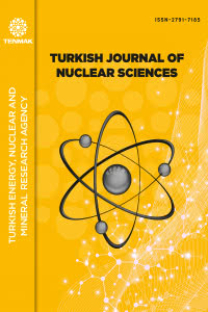AKTİF KARBON ÜZERİNE URANYUM ADSORBSİYONUNUN İNCELENMESİ
Aktif karbonun, yüksek sıcaklığa ve yüksek radyasyon dozuna karşı kararlılığı nedeniyle nükieer teknoloji alanında geniş bir kullanım alanı vardır. Ticari aktif karbon (Merck 2183) üzerine uranyum adsorpsiyonu çalkalama süresi, pH, başlangıç uranyum konsantrasyonu ve sıcaklığın bir fonsiyonu olarak incelenmiştir. Uranyum adsorpsiyon verimi %97±1 olarak bulunmuştur.
Anahtar Kelimeler:
Aktif karbon, Nükleer teknoloji
INVESTIGATION OF URANIUM ADSORPTION ON ACTIVATED CARBON
Activated carbon is widely used in the field of nuclean technology because of some specific properties, such as stability towards high temperature and high dose of radiation. The adsorption of aranium on commercially available activated carbon (Merck 2183) has been studied as a function of shaking time, pH, concentration of adsorbate and temperature. The uranium adsorption efficiency was found as 97 ± 1 %.
Keywords:
activated carbon, nuclear technology,
___
- Qadeer, R., Hanif, J., “Kinetics of Uranium (VI) Ions Adsorption on Activated Charcoal from Aqueous Solutions”. Radiochimica Acta, 65 (1994) 259.
- Abbasi, W. A., Streat, M., “Adsorption of Uranium from Aqueous Solutions Using Activated Carbon”. Separation Science and Technology, 29 (1994) 1217.
- Saleem, M., Afzal, M., Qadeer, R., Hanif, J., “Selective Adsorption of Uranium on Activated Charcoal From Electrolytic Aqueous Solutions”. Separation Science and Technology, 27 (1992) 239.
- Kabay, N„ Egawa, H., “Recent Advances in the Development of Chelating Polymers for Recovery of Uranium from Seawater”. Doğa-Tr. J. Of Chemistry, 17 (1993) 62.
- Sakaguchi, T., Nakajima, A., “Recovery of Uranium by Immobilized Polyhydroxyanthraquinone.” Separation Science and Technology, 21 (1986) 519.
- Teng, H., Lin, H-C., “Activated Carbon Production from Low Ash subbituminous Coal with CO2 Activation”. AlChE Journal, 44 (1998) 1170.
- Ahmadpour, a., King, B. A. Do, D. D., “Comparison of Equilibria an Kinetics of High Surface Area Activated Carbon Produced from Different Precursors and by Different Chemical Treatments”. Ind. Eng. Chem Res., 37 (1998) 1329.
- Başlangıç: 1981
- Yayıncı: -
Sayıdaki Diğer Makaleler
Investigation of uranium adsorption on activated carbon
M. KARADENİZ, C. KÜTAHYALI, M. ERAL
AKTİF KARBON ÜZERİNE URANYUM ADSORBSİYONUNUN İNCELENMESİ
M KARADENİZ, C KÜTAHYALI, M ERAL
NORMAL ÇALIŞMA KOŞULLARINDA HTR-10 İÇİN NEUTRONIC VE TERMAL-HİDROLİK PERFORMANSIN İNCELENMESİ
IŞINLAMANIN NEMATODIRUS SP. YUMURTALARININ CANLILIĞI VE ENFEKTİVİTELERİNE ETKİSİ
